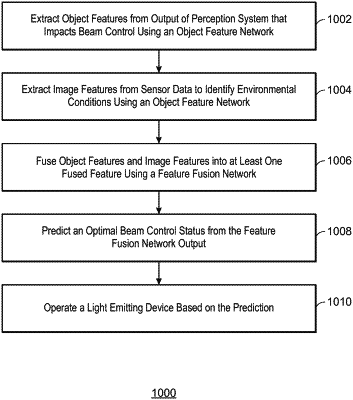| CPC B60Q 1/085 (2013.01) [B60Q 1/143 (2013.01); G06V 20/56 (2022.01); G06V 20/584 (2022.01); G06F 2218/08 (2023.01)] | 20 Claims |

|
1. A system, comprising:
at least one processor; and
at least one memory storing instructions thereon that, when executed by the at least one processor, cause the at least one processor to:
extract object features from a perception system output to identify objects in an environment using an object feature network, wherein the object feature network outputs object features associated with a map prior used to extract a distance associated with the objects, wherein the distance governs an illumination intensity output by a light emitting device;
extract image features from sensor data to identify environmental illumination information using an image feature network, wherein the image feature network outputs image features that comprise environmental information and data associated with an illumination of the environment;
fuse the object features and the image features into fused features using a feature fusion network that takes as input the object features and the image features and outputs fused features;
predict a beam control status according to the fused features, wherein the beam control status indicates a high beam illumination intensity or a low beam illumination intensity of the light emitting device; and
a control circuit communicatively coupled to the at least one processor, wherein the control circuit is configured to operate the light emitting device based upon the beam control status.
|